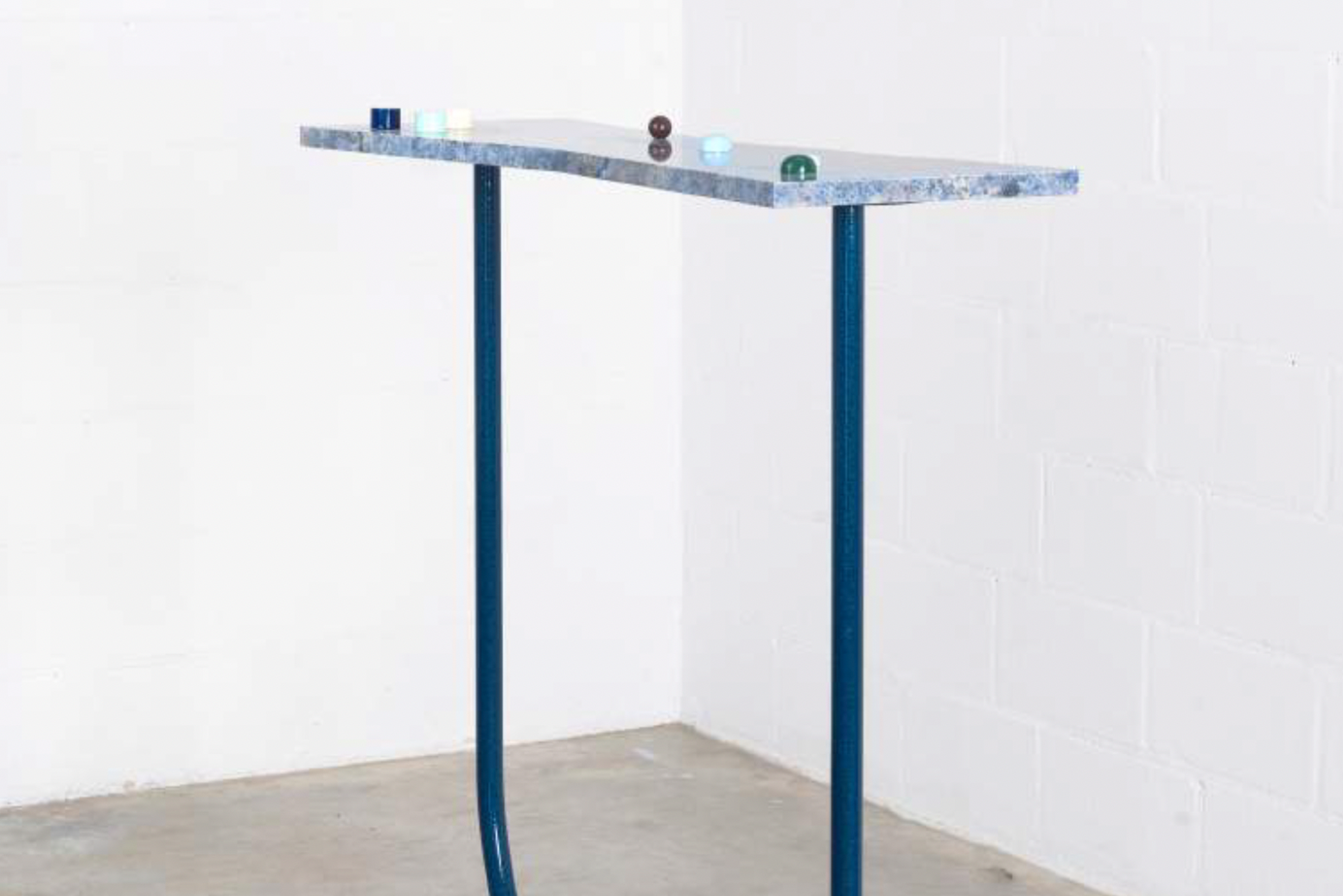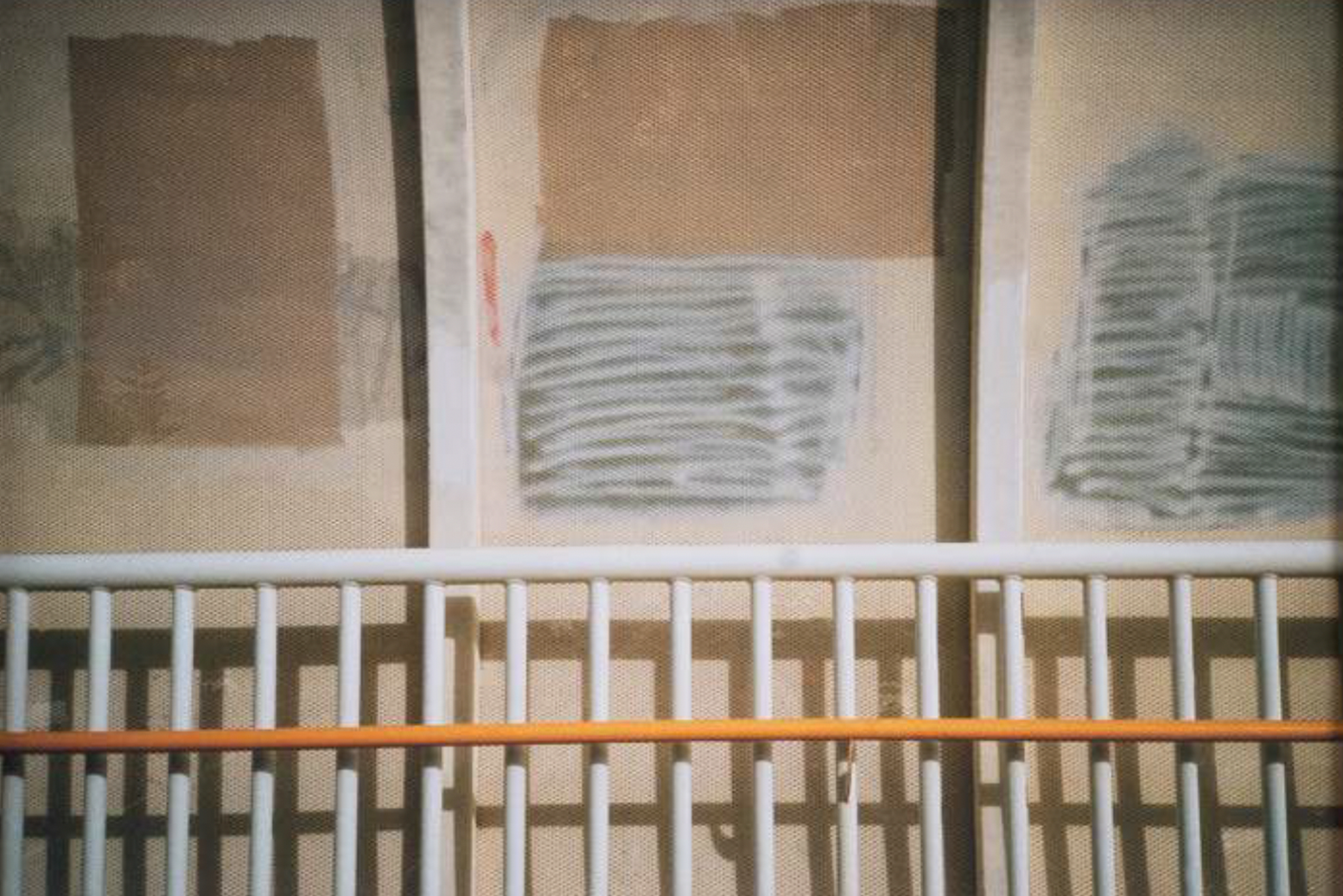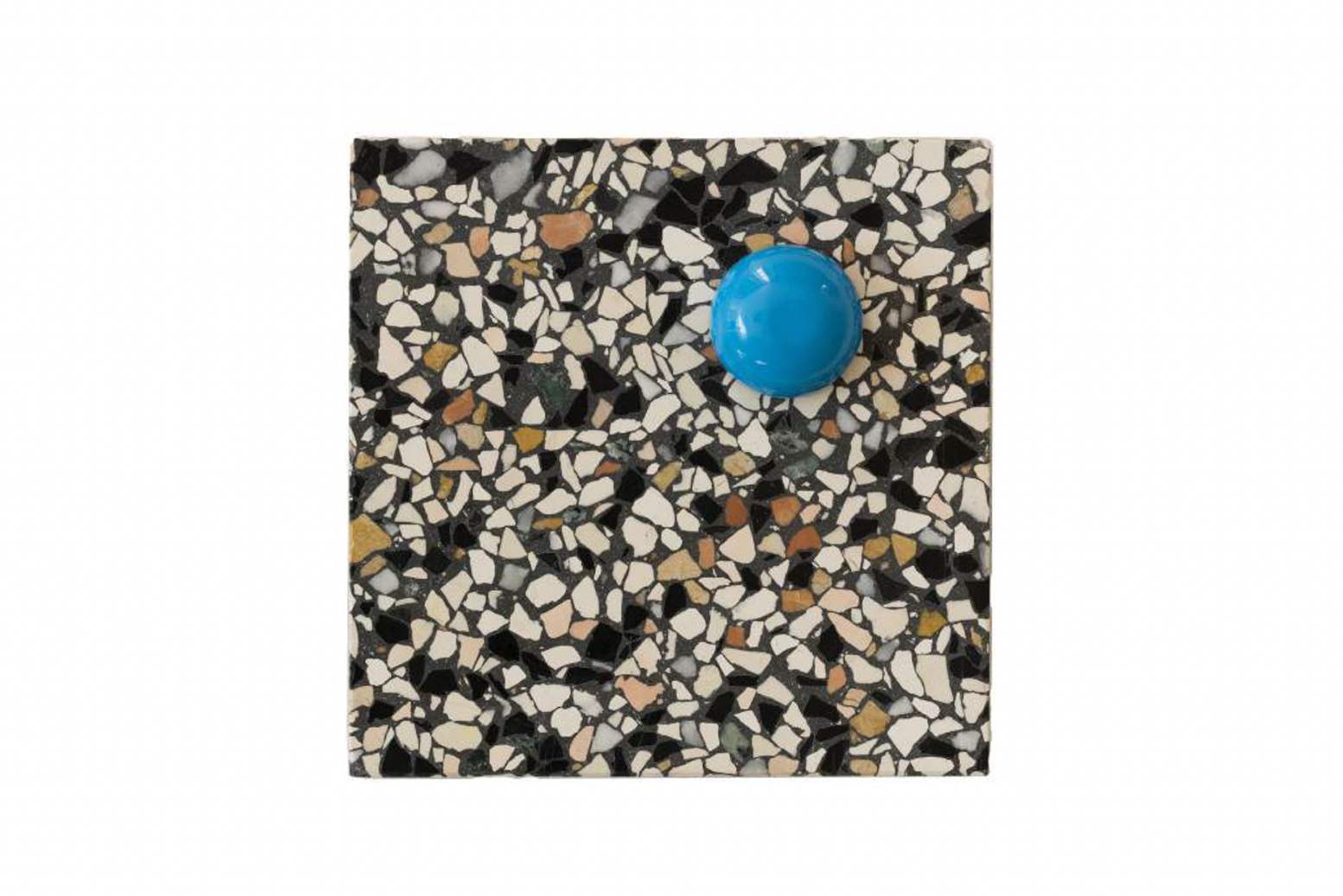


Sam Bloor has been spray-painting, tattooing, signwriting, and stickering his way around Boorloo and Walyalup for over a decade. Whether realising it or not, you’ve likely contemplated a Bloor or two in your time. He is perhaps most well-known for his Billboard Project during the Fremantle Biennale in 2019, and the Fremantle Ferris Wheel installation which accompanied his exhibition That Sinking Feeling, part of the 2022 Perth Festival. Both projects are indebted to the likes of Jenny Holzer and the late Lawrence Weiner and John Baldessari, repurposing their text-based interventions for a Freo context. Admittedly, “intervention” is a word overused in the art world, which leads me to wonder if everything is an “intervention”, then perhaps nothing is.[1] Yet, Bloor’s Billboards are interventions of a sort—prominent from their urban surrounds and presenting open-ended phrases geared for contemplation by an unsuspecting viewer. The best of these provide poetically charged phrases, while the weakest skirt a touch too close to self-help affirmations. En masse, the effect of the signs is striking. Now, Bloor leaves the streets (and the signwriting) and returns to the gallery to present a series of sculptures and photographs in his latest exhibition 09/06. Attentively curated and installed at Kolbusz Space, 09/06 adds to the half dozen solo shows Bloor has under his belt. The culmination of years of work, this exhibition draws upon “elements of found painting, energetic mark-making, and hostile architecture in the voice of the contemporary post-vandalism movement”. My attention is piqued—Post-what?
Intrigued, I peered into the world of post-vandalism, an ism unfamiliar to me. Post-vandalism appears to have originated in Central Europe, used by artists and academics such as Maurycy Gomulicki and Adam Jastrzebski in the early/mid-2010s to describe work that repurposed the aesthetics of graffiti and protest culture for the gallery. The term was popularised by Stephen Burke, an Irish artist and curator who established the Instagram account @post_vandalism around January 2019, and who contributes the essay to Bloor’s exhibition catalogue.
The @post_vandalism account reshares the work of artists deemed to fit into the aesthetic paradigm of post-vandalism (Bloor’s work was first shared in June 2019). Burke went on to curate the exhibition Post Vandalism at the commercial London-based gallery OMNI in 2022. He explains, the movement ‘considers the relationship between public space and the act of destruction, both materially and conceptually’.[2] Exploring post-vandalism further, one becomes saturated with visions of spray painted canvases, bits of fences, pallet crates, repurposed anti-loitering devices, and skateboard prevention brackets.[3] This urban hardware is utilised in every combination imaginable to produce installations, sculptures and images. What at first are curious material motifs become clichés due to sheer ubiquity.
Rather than the radical acts of the vandal, the post-vandal reconstitutes the aesthetic residue of destruction into desirable commodities. The prefix post- suggests a kind of omniscient understanding of the modified vandalism; post-vandalism proposes that we are now operating in a paradigm in which vandalism is an aesthetic as much as an action. The visual qualities or signifiers associated with vandalism are now subsumed into the broader artistic lexicon. By this logic, to be a post-vandal is to say vandalism is a noun, not a verb; a technique, not an action; teachable, able to be theorised and categorised, classified into genres and debated in terms of taste. By virtue of the terms above, a post-vandal is by no means radical. The post-vandal creates work for a contemporary art market desirous of slick art objects which gesture toward political issues. Ironically, the very issues or conditions of oppression that the work comments on are those which provide the critical edge that give it value. If true, the post-vandal is an interior designer with a mind for populist politics. The most dynamic intellectual pirouette comes in the form of the aggrandising logic one must apply to view the post-vandal’s work as radical: This work subverts notions of [fill in the blank]. It is an overused phrase often employed to enhance market-ready contemporary art with a nifty flourish of social politics, so that the work is no longer just an image or form. At least, that is what some of the commodified combine-paintings, crisp photographs and slick sculptural installations of the post-vandalism movement suggest.
Interestingly, these competing ideals (the radical and commercial) are not unfamiliar to Bloor either. In the past, Bloor has demonstrated more nous than fellow post-vandals. His commitment to activities often considered counter-cultural (tattooing, graffiti, conceptual art) and commercial (signwriting, design and the production of merchandise) sets up an opposition which Bloor has successfully synthesised in the past, such as in his aforementioned Billboard project. Unfortunately, in 09/06 however, this contrast does not yield the same dynamism. Comprising a dozen works, the curation of 09/06 is measured and coherent, with powder blue feature walls neatly accentuating particular photographic works.
Small square terrazzo tiles adorned with an anti-skating device titled Tension Studies appear to this reviewer as overly simple and somewhat odd material combinations. Sure, one could consider them a critique by way of contrasting opulent materials with oppressive items. Yet, extrapolation reveals little more about these miniature abstractions which, upon concentrated looking, one appreciates are simply minimalist ornaments.
These studies appear the preparatory work behind the show’s three full sized sculptures. Among these, Bribe is a U-shaped steel base upon which sits a marble shelf-of-sorts, bedazzled with assorted colourful anti-loitering and anti-skateboarding devices. The fabrication is flawless, with Bloor exercising great care in his selection and use of materials. In the gallery the scale and form is familiar, perhaps resembling an in-vogue item of furniture—and, if it were, and you were to place an object upon it, carefully avoiding the anti-loitering knobs, then perhaps you would be reminded that we are not as free as we think. Another sculpture, Coax, applies similar materials and logic to the form of a lectern. The gorgeous piece of marble Bloor has selected is decorated with painted anti-loitering and anti-skateboarding devices. Burke notes that the ‘deliberate choice of form encourages viewers to further think about the power dynamics and symbolic significance associated with the lectern.’ Coax is a curious object that arrests one’s attention, yet, to me, the result of sustained looking yields similar results to the terrazzo tension studies.
Bloor’s photography catches my eye. Among the various close crops of urban scenes, Your Bruise stands out. It is a fun photographic abstraction depicting, in detail, a wall that has received various paintjobs to remove tags and graffiti (and perhaps just to touch up signs of deterioration). Harshly cropping what would have been more traditionally figurative, the abstraction focuses our attention to the surfaces and, interestingly for a photograph, to paint as the subject. Adjacent is another abstracted street scene, Lipstick on the Filter, a photograph of a walkway with a hasty patchwork of local council graffiti abatement, barely disguising (in fact emphasising!) the erstwhile graffiti. The photographs are the most compelling moments in the show and the works which best achieve the aims set out in Burke's essay.
While chatting with a friend about these photographs, the conversation suddenly turns to the Boorloo Aesthetics Facebook page. Waving their phone at me, they exclaim ‘Bloor’s the mattress man!’ I am shown a carousel of images of mattresses around Leederville with seemingly intimate phrases spraypainted on them. Some are simply great images—one shows a mattress, perhaps verge collection, leaned up against a tree with “ALL I DO IS DREAM OF YOU” sprayed in dark mauve paint. At once funny and light-hearted, grimy and nostalgic, these images present a far more compelling example of what post-vandalism could be: a schema for exploring the poetics that resist our ever more controlled, monitored and volatile world.
Sam Bloor, 09/06, 9 - 11 Jun 2023, Kolbusz Space.
1. Or, as Syndrome in The Incredibles film says, ‘when everyone is super, then no one will be!’
2. Stephen Burke in https://www.omnigallery.com/viewing-room/8-post-vandalism-group-exhibition/
3. These are little knobs of stainless steel which are installed on benches and ledges to deter skaters from performing sick grinds.
Image credits:
1. Sam Bloor, Bribe, 2023. Marble, assorted anti-loitering / anti-skateboarding devices, hammer powder coated steel. 100 x 90 x 37 cm.
2. Sam Bloor, Lipstick on the Filter, 2023. 35mm photo on archival rag in custom coloured and shaped frame. 62 x 42 cm.
3. Sam Bloor, Tension Study (Blue), 2023. Anti-skateboarding device, terrazzo tile. 12.5 x 12.5 cm.
Intrigued, I peered into the world of post-vandalism, an ism unfamiliar to me. Post-vandalism appears to have originated in Central Europe, used by artists and academics such as Maurycy Gomulicki and Adam Jastrzebski in the early/mid-2010s to describe work that repurposed the aesthetics of graffiti and protest culture for the gallery. The term was popularised by Stephen Burke, an Irish artist and curator who established the Instagram account @post_vandalism around January 2019, and who contributes the essay to Bloor’s exhibition catalogue.
The @post_vandalism account reshares the work of artists deemed to fit into the aesthetic paradigm of post-vandalism (Bloor’s work was first shared in June 2019). Burke went on to curate the exhibition Post Vandalism at the commercial London-based gallery OMNI in 2022. He explains, the movement ‘considers the relationship between public space and the act of destruction, both materially and conceptually’.[2] Exploring post-vandalism further, one becomes saturated with visions of spray painted canvases, bits of fences, pallet crates, repurposed anti-loitering devices, and skateboard prevention brackets.[3] This urban hardware is utilised in every combination imaginable to produce installations, sculptures and images. What at first are curious material motifs become clichés due to sheer ubiquity.
Rather than the radical acts of the vandal, the post-vandal reconstitutes the aesthetic residue of destruction into desirable commodities. The prefix post- suggests a kind of omniscient understanding of the modified vandalism; post-vandalism proposes that we are now operating in a paradigm in which vandalism is an aesthetic as much as an action. The visual qualities or signifiers associated with vandalism are now subsumed into the broader artistic lexicon. By this logic, to be a post-vandal is to say vandalism is a noun, not a verb; a technique, not an action; teachable, able to be theorised and categorised, classified into genres and debated in terms of taste. By virtue of the terms above, a post-vandal is by no means radical. The post-vandal creates work for a contemporary art market desirous of slick art objects which gesture toward political issues. Ironically, the very issues or conditions of oppression that the work comments on are those which provide the critical edge that give it value. If true, the post-vandal is an interior designer with a mind for populist politics. The most dynamic intellectual pirouette comes in the form of the aggrandising logic one must apply to view the post-vandal’s work as radical: This work subverts notions of [fill in the blank]. It is an overused phrase often employed to enhance market-ready contemporary art with a nifty flourish of social politics, so that the work is no longer just an image or form. At least, that is what some of the commodified combine-paintings, crisp photographs and slick sculptural installations of the post-vandalism movement suggest.
Interestingly, these competing ideals (the radical and commercial) are not unfamiliar to Bloor either. In the past, Bloor has demonstrated more nous than fellow post-vandals. His commitment to activities often considered counter-cultural (tattooing, graffiti, conceptual art) and commercial (signwriting, design and the production of merchandise) sets up an opposition which Bloor has successfully synthesised in the past, such as in his aforementioned Billboard project. Unfortunately, in 09/06 however, this contrast does not yield the same dynamism. Comprising a dozen works, the curation of 09/06 is measured and coherent, with powder blue feature walls neatly accentuating particular photographic works.
Small square terrazzo tiles adorned with an anti-skating device titled Tension Studies appear to this reviewer as overly simple and somewhat odd material combinations. Sure, one could consider them a critique by way of contrasting opulent materials with oppressive items. Yet, extrapolation reveals little more about these miniature abstractions which, upon concentrated looking, one appreciates are simply minimalist ornaments.
These studies appear the preparatory work behind the show’s three full sized sculptures. Among these, Bribe is a U-shaped steel base upon which sits a marble shelf-of-sorts, bedazzled with assorted colourful anti-loitering and anti-skateboarding devices. The fabrication is flawless, with Bloor exercising great care in his selection and use of materials. In the gallery the scale and form is familiar, perhaps resembling an in-vogue item of furniture—and, if it were, and you were to place an object upon it, carefully avoiding the anti-loitering knobs, then perhaps you would be reminded that we are not as free as we think. Another sculpture, Coax, applies similar materials and logic to the form of a lectern. The gorgeous piece of marble Bloor has selected is decorated with painted anti-loitering and anti-skateboarding devices. Burke notes that the ‘deliberate choice of form encourages viewers to further think about the power dynamics and symbolic significance associated with the lectern.’ Coax is a curious object that arrests one’s attention, yet, to me, the result of sustained looking yields similar results to the terrazzo tension studies.
Bloor’s photography catches my eye. Among the various close crops of urban scenes, Your Bruise stands out. It is a fun photographic abstraction depicting, in detail, a wall that has received various paintjobs to remove tags and graffiti (and perhaps just to touch up signs of deterioration). Harshly cropping what would have been more traditionally figurative, the abstraction focuses our attention to the surfaces and, interestingly for a photograph, to paint as the subject. Adjacent is another abstracted street scene, Lipstick on the Filter, a photograph of a walkway with a hasty patchwork of local council graffiti abatement, barely disguising (in fact emphasising!) the erstwhile graffiti. The photographs are the most compelling moments in the show and the works which best achieve the aims set out in Burke's essay.
While chatting with a friend about these photographs, the conversation suddenly turns to the Boorloo Aesthetics Facebook page. Waving their phone at me, they exclaim ‘Bloor’s the mattress man!’ I am shown a carousel of images of mattresses around Leederville with seemingly intimate phrases spraypainted on them. Some are simply great images—one shows a mattress, perhaps verge collection, leaned up against a tree with “ALL I DO IS DREAM OF YOU” sprayed in dark mauve paint. At once funny and light-hearted, grimy and nostalgic, these images present a far more compelling example of what post-vandalism could be: a schema for exploring the poetics that resist our ever more controlled, monitored and volatile world.
Sam Bloor, 09/06, 9 - 11 Jun 2023, Kolbusz Space.
1. Or, as Syndrome in The Incredibles film says, ‘when everyone is super, then no one will be!’
2. Stephen Burke in https://www.omnigallery.com/viewing-room/8-post-vandalism-group-exhibition/
3. These are little knobs of stainless steel which are installed on benches and ledges to deter skaters from performing sick grinds.
Image credits:
1. Sam Bloor, Bribe, 2023. Marble, assorted anti-loitering / anti-skateboarding devices, hammer powder coated steel. 100 x 90 x 37 cm.
2. Sam Bloor, Lipstick on the Filter, 2023. 35mm photo on archival rag in custom coloured and shaped frame. 62 x 42 cm.
3. Sam Bloor, Tension Study (Blue), 2023. Anti-skateboarding device, terrazzo tile. 12.5 x 12.5 cm.
